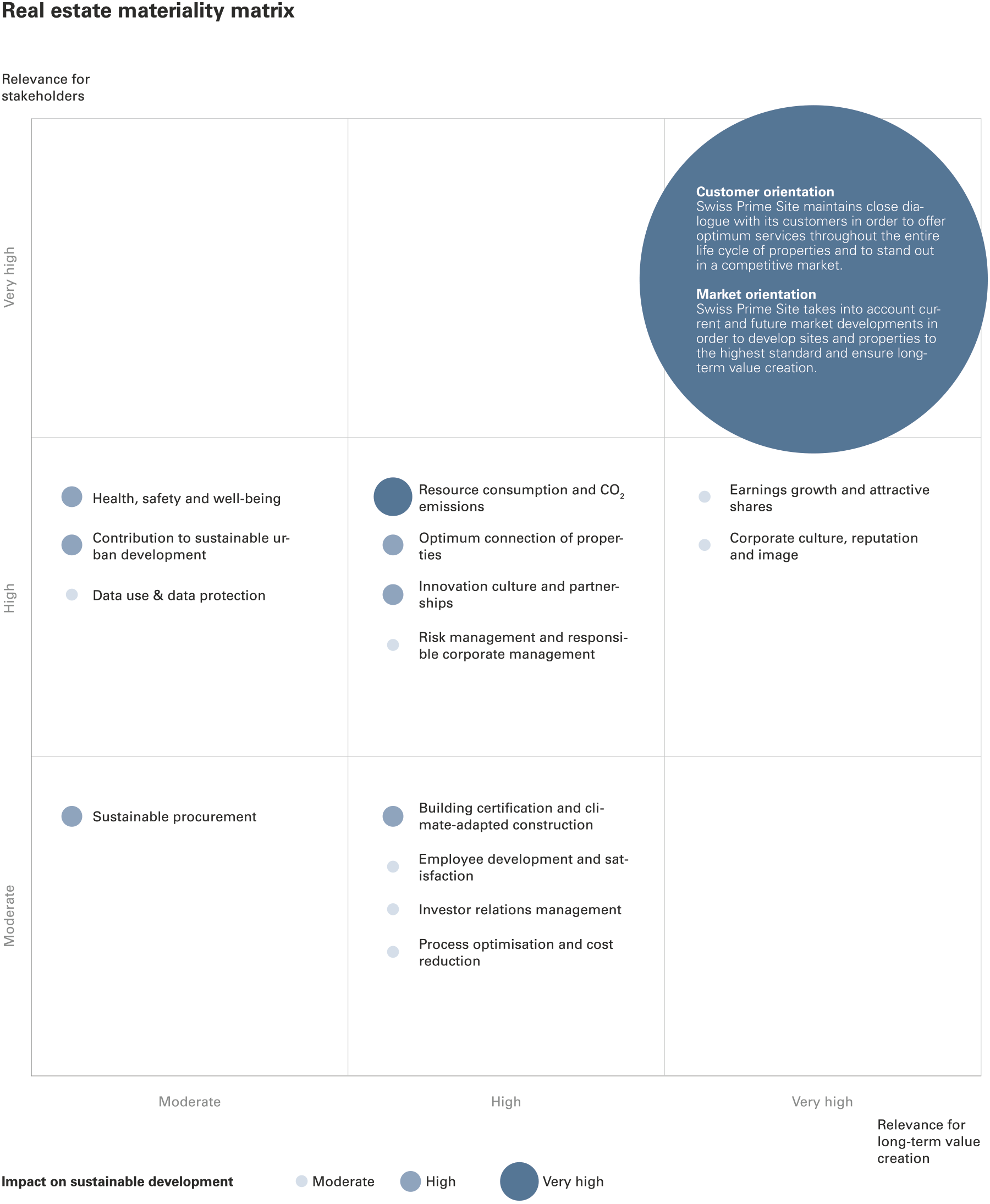Materiality analysis
During the 2019 materiality analysis, Swiss Prime Site determined which issues are particularly important to its stakeholders and to safeguarding its short-, medium- and long-term business success. The Company also evaluated which issues have a significant impact on economic, social and environmental development. The materiality analysis thereby forms the basis for the strategic focus of reporting, as well as for the integration of important financial and non-financial issues into the management of the group (GRI 102-49).
Differentiated approach in three fields of activity
Due to their different characteristics, the various business activities of Swiss Prime Site call for a differentiated view of the material issues. The materiality analysis was therefore performed from the perspective of the following fields of activity:
- Real estate (Swiss Prime Site Immobilien, Wincasa, Swiss Prime Site Solutions)
- Retail (Jelmoli)
- Assisted living (Tertianum Group)
This approach made it possible to tailor the issues more to the different activities and their company-specific characteristics during the analysis. In the area of assisted living, for example, the health and safety of guests was identified as a key issue, while in the retail area aspects such as brand strategy and customer footfall were covered. For real estate, optimum connection of the properties, as well as resource consumption and CO2 emissions, were highlighted as key factors.
The issues, which are prioritised on the basis of their materiality, are arranged according to the six capitals that determine the structure of the sustainability roadmap: stakeholders, finance, infrastructure, innovation, ecology and employees. The six capitals correspond to the sustainability dimensions introduced in 2016 and reflect the Company’s integrated approach to creating sustainable value for the various stakeholder groups from a wide range of resources.
For each field of activity, the aim was to assess how important the particular issues are to the different stakeholders on the one hand, and to the business success of Swiss Prime Site on the other, and also how important the issue is with regard to the Company’s impact on sustainable development. This procedure is derived from the sustainability reporting guidelines of the Global Reporting Initiative (GRI), which describe how to evaluate stakeholder relevance and assess impact. Assessing business relevance as the third dimension ensures that the material issues are closely related to the core business and can be integrated into the strategic management. The process is therefore also compatible with the recommendations of the International Integrated Reporting Council (IIRC).
Integration of internal and external stakeholders
To assess business relevance, representatives of the company management were interviewed. In order to include the opinions of the most important external stakeholders, Swiss Prime Site conducted an online survey. A total of 36 members of the Executive Board and Management Board, as well as 23 external stakeholders, were invited to take part in the assessment. The Company also took into account the findings of the 2019 Stakeholder Panel. The impact dimension was assessed in an internal analysis. The next materiality review will be conducted as part of the 2021 Stakeholder Panel (GRI 102-46).
Results of the materiality analysis
The following illustrations show which issues were deemed to be material in the materiality analysis in the three dimensions «relevance to stakeholders», «relevance to long-term value creation» and «impact on sustainable development». The focus here is on the results of the core real estate business.
Inclusion of material issues in goal setting
The materiality analysis serves to align the financial and non-financial reporting with these material issues. The identified issues are systematically covered in this Annual Report and in the accompanying GRI Report. The materiality analysis also serves as a starting point for further improving the integrated management of financial and non-financial aspects. During the implementation of the sustainability roadmap, the Company defines goals from which it then derives measures that correspond to the material issues.
